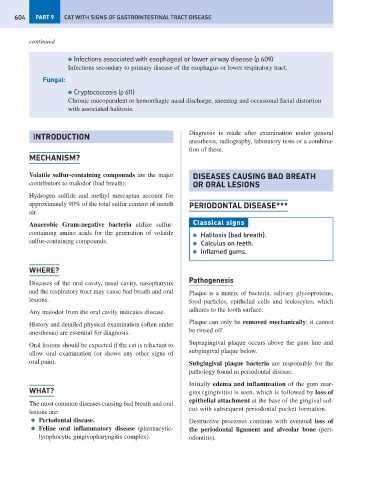Page 612 - Problem-Based Feline Medicine
P. 612
604 PART 9 CAT WITH SIGNS OF GASTROINTESTINAL TRACT DISEASE
continued
● Infections associated with esophageal or lower airway disease (p 609)
Infections secondary to primary disease of the esophagus or lower respiratory tract.
Fungal:
● Cryptococcosis (p 611)
Chronic mucopurulent or hemorrhagic nasal discharge, sneezing and occasional facial distortion
with associated halitosis.
Diagnosis is made after examination under general
INTRODUCTION
anesthesia, radiography, laboratory tests or a combina-
tion of these.
MECHANISM?
Volatile sulfur-containing compounds are the major DISEASES CAUSING BAD BREATH
contributors to malodor (bad breath). OR ORAL LESIONS
Hydrogen sulfide and methyl mercaptan account for
approximately 90% of the total sulfur content of mouth PERIODONTAL DISEASE***
air.
Anaerobic Gram-negative bacteria utilize sulfur- Classical signs
containing amino acids for the generation of volatile ● Halitosis (bad breath).
sulfur-containing compounds. ● Calculus on teeth.
● Inflamed gums.
WHERE?
Diseases of the oral cavity, nasal cavity, nasopharynx Pathogenesis
and the respiratory tract may cause bad breath and oral Plaque is a matrix of bacteria, salivary glycoproteins,
lesions. food particles, epithelial cells and leukocytes, which
Any malodor from the oral cavity indicates disease. adheres to the tooth surface.
History and detailed physical examination (often under Plaque can only be removed mechanically; it cannot
anesthesia) are essential for diagnosis. be rinsed off.
Oral lesions should be expected if the cat is reluctant to Supragingival plaque occurs above the gum line and
allow oral examination (or shows any other signs of subgingival plaque below.
oral pain). Subgingival plaque bacteria are responsible for the
pathology found in periodontal disease.
Initially edema and inflammation of the gum mar-
WHAT? gins (gingivitis) is seen, which is followed by loss of
epithelial attachment at the base of the gingival sul-
The most common diseases causing bad breath and oral
cus with subsequent periodontal pocket formation.
lesions are:
● Periodontal disease. Destructive processes continue with eventual loss of
● Feline oral inflammatory disease (plasmacytic- the periodontal ligament and alveolar bone (peri-
lymphocytic gingivopharyngitis complex). odontitis).

